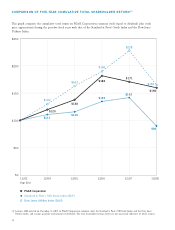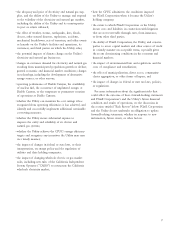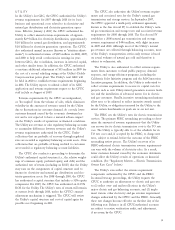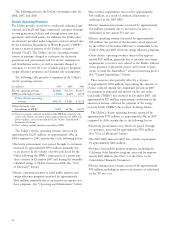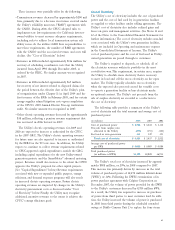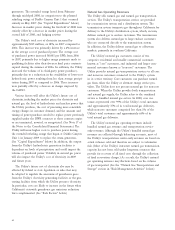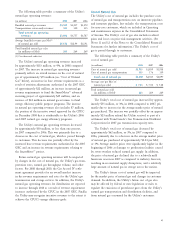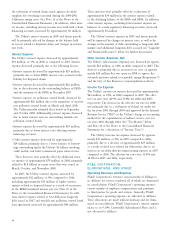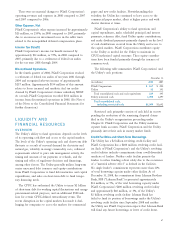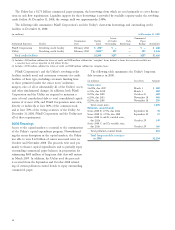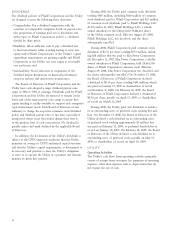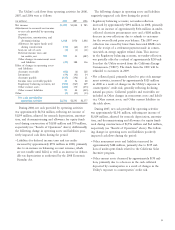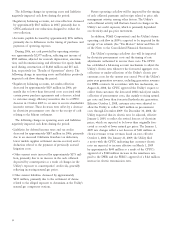PG&E 2008 Annual Report Download - page 44
Download and view the complete annual report
Please find page 44 of the 2008 PG&E annual report below. You can navigate through the pages in the report by either clicking on the pages listed below, or by using the keyword search tool below to find specific information within the annual report.42
Natural Gas Operating Revenues
The Utility sells natural gas and natural gas transportation
services. The Utility’s transportation services are provided
by a transmission system and a distribution system. The
transmission system transports gas throughout California for
delivery to the Utility’s distribution system, which, in turn,
delivers natural gas to end-use customers. The transmission
system also delivers natural gas to large end-use customers
who are connected directly to the transmission system.
In addition, the Utility delivers natural gas to off-system
markets, primarily in southern California.
The Utility’s natural gas customers consist of two
categories: residential and smaller commercial customers
known as “core” customers, and industrial and larger com-
mercial customers known as “non-core” customers. The
Utility provides natural gas transportation services to all core
and non-core customers connected to the Utility’s system
in its service territory. Core customers can purchase natural
gas from either the Utility or alternate energy service pro-
viders. The Utility does not procure natural gas for non-core
customers. When the Utility provides both transportation
and natural gas supply, the Utility refers to the combined
service as bundled natural gas service. In 2008, core cus-
tomers represented over 99% of the Utility’s total customers
and approximately 37% of its total natural gas deliveries,
while non-core customers comprised less than 1% of the
Utility’s total customers and approximately 63% of its
total natural gas deliveries.
The Utility’s natural gas operating revenues include
bundled natural gas revenues and transportation service-
only revenues. Although the Utility’s bundled natural gas
revenues are collected through balancing accounts, most of
the Utility’s transportation service-only revenues are based on
actual volumes sold and therefore are subject to volumetric
risk. (Most of the Utility’s intrastate natural gas transmission
capacity has not been sold under long-term contracts that
provide for recovery of all fi xed costs through the collection
of fi xed reservation charges.) As a result, the Utility’s natural
gas operating revenues may fl uctuate based on the volume
of gas transported. (See the “Natural Gas Transportation and
Storage” section in “Risk Management Activities” below.)
generators. The extended outage lasted from February
through mid-April 2008, in comparison to the planned
refueling outage of Diablo Canyon Unit 1 that occurred
entirely in May 2007. (See “Capital Expenditures” below.)
Increases in market prices during the fi rst half of 2008 were
entirely offset by a decrease in market prices during the
second half of 2008, and hedging activity.
The Utility’s total cost of electricity increased by
approximately $515 million, or 18%, in 2007 compared to
2006. This increase was primarily driven by a 6% increase
in the average cost of purchased power. The average cost
of purchased power increased $0.005 per kWh from 2006
to 2007, primarily due to higher energy payments made to
qualifying facilities after their fi ve-year fi xed price contracts
expired during the summer of 2006. In addition, the Utility
increased the volume of its third-party power purchases,
primarily due to a reduction in the availability of lower-cost
hydroelectric power resulting from less than average precipi-
tation during 2007 as compared to 2006. These increases
were partially offset by a decrease in charges imposed by
the CAISO.
Various factors will affect the Utility’s future cost of
electricity, including the market prices for electricity and
natural gas, the level of hydroelectric and nuclear power that
the Utility produces, the cost of procuring more renewable
energy, changes in customer demand, and the amount and
timing of power purchases needed to replace power previously
supplied under the DWR contracts as those contracts expire
or are terminated, novated, or renegotiated. (See Note 17 of
the Notes to the Consolidated Financial Statements.) The
Utility will incur higher costs to purchase power during
the extended refueling outage that began at Diablo Canyon
Unit 1 in January 2009 to replace the steam generators.
(See “Capital Expenditures” below.) In addition, the output
from the Utility’s hydroelectric generation facilities is
dependent on levels of precipitation and could impact the
volume of purchased power. Volatility in natural gas prices
will also impact the Utility’s cost of electricity in 2009
and future years.
The Utility’s future cost of electricity also may be
affected by federal or state legislation or rules that may
be adopted to regulate the emissions of greenhouse gases
from the Utility’s electricity generating facilities or the gen-
erating facilities from which the Utility procures electricity.
In particular, costs are likely to increase in the future when
California’s statewide greenhouse gas emissions reduction
law is implemented. (See “Risk Factors” below.)


